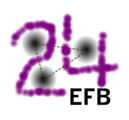Speaker
Description
In latest years, there have been a promptly increasing number of experimental and theoretical publications focusing on transition metal dichalcogenides (TMD) crystals. Quantum dots TMD have the potential to combine the essential features of both optically active and electrically defined quantum dots. Strong electron–hole binding in TMDs suggests that it would be possible to obtain a discrete spectrum due to trapping of trions and biexcitons in strong electric or magnetic fields. The properties of the charged excitons and biexcitons in a parabolic quantum dot in an external magnetic field are studied using an effective-mass Hamiltonian. The Hamiltonian is written in terms of the center of mass and relative coordinates. The Schrödinger equation for electron – hole systems in a quantum dot in a magnetic field was solved in the framework of the hyperspherical functions method. We assume that electrons and holes are interacted via Ritova- Keldysh potential [1]. It is shown that the ground state properties are approximately determined by that part of the total Hamiltonian that depends only on relative coordinates.
[1]. N. S. Rytova, Proc. MSU Phys., Astron. 3, 30, (1967); L.V.Keldysh, JETP Lett. 29, 658, (1979).
